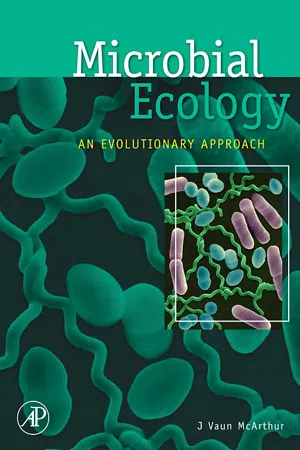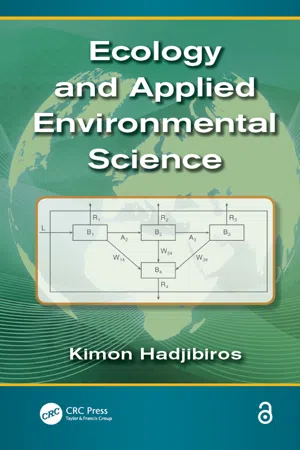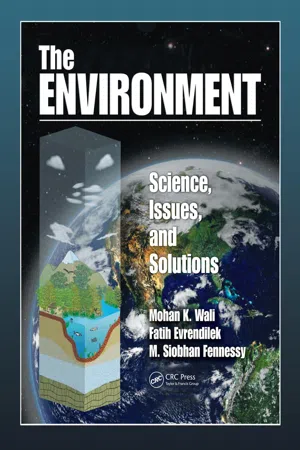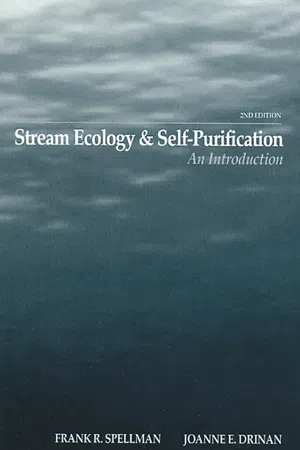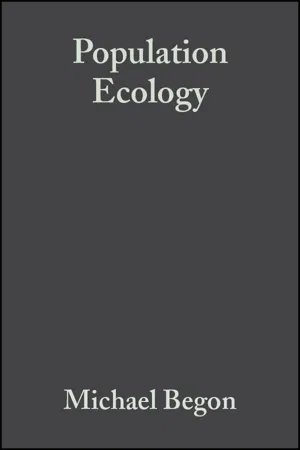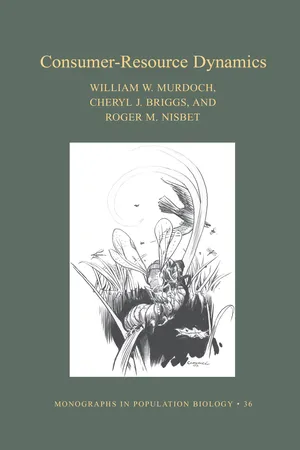Biological Sciences
Populations
Populations refer to groups of organisms of the same species that live in the same area and interact with one another. In biological sciences, the study of populations involves examining their size, density, distribution, and genetic composition, as well as the factors that influence these characteristics. Understanding populations is crucial for ecological and evolutionary research, conservation efforts, and management of natural resources.
Written by Perlego with AI-assistance
Related key terms
1 of 5
10 Key excerpts on "Populations"
- eBook - PDF
Microbial Ecology
An Evolutionary Approach
- J Vaun McArthur(Author)
- 2006(Publication Date)
- Academic Press(Publisher)
Living Together in Populations III Fundamentals of Microbial Population Ecology 7 Populations in Ecology Populations in ecology are often defined as groups of interbreeding individuals. This definition is not satisfactory for most of the world’s biota. All asexual and parthenogenic organisms, regardless of their densities, would not be Populations based on that definition. A more general definition of an ecological population might be a group of like organisms living in a defined area in a specific period of time. Whether the number of organisms is 2 or 10 million does not matter. The boundaries of Populations vary both in space and time. They are difficult to determine and are usually defined by the specific investigator. For example, a researcher may define the population of interest to be the enteric bacteria found in the gut of a single human host. The spatial bounds of this popula-tion may appear to be set. However, enteric bacteria from other humans and animals may enter the specific human host, and the real population includes all potential col-onizers and the resident members. The strains of enteric bacteria of a single human host may change over time. The structure of a population at time T 0 may be very dif-ferent from the population found at time T 1 . The physical boundaries of some pop-ulations are ridiculous to consider but still may have important ecological impacts. One such example might be considering the population of a specific species of bac-teria found in the oceans. Properties of Populations Populations have properties (primarily statistical) that cannot be applied to indi-viduals. They have meaning only in Populations. These include measures such as density or size of the population. Density refers to the number of individuals per unit area. We do not speak of the density of an individual. There are four characteristics that affect the size of a population: births, deaths, immigration, and emigration. - eBook - PDF
Ecology
Principles and Applications
- J. L. Chapman, M. J. Reiss(Authors)
- 1998(Publication Date)
- Cambridge University Press(Publisher)
FOUR Population dynamics 4.1 Populations and population change Organisms do not live solitary lives in isolation from other members of their species. Usually they live in groups or, if normally single, they interact with other members of their species at various times in their lives. A group of organisms of the same species which live together in one geographical area at the same time is called a population. Within a population, all the individuals capable of reproduction have the opportunity to reproduce with other mature mem- bers of the group. Although it is quite easy to define a population on paper, it is often difficult to study one in its natural environment (Crawley, 1990). First of all, the species to be investigated has to be identified. This is often easy, but may be difficult in some taxa or in particu- lar circumstances. For example, insects often require microscopic scrutiny, one species in a mixed flock of birds may be difficult to pick out and count accu- rately, and plants sometimes hybridise with other species or occur as difficult taxonomic aggregates (see Section 6.2.5). The second problem is to decide what is an individual in the population. The bracken fronds in Figure 3.1, for example, are all members of one clone, that is one genetic individual, although they may look like a lot of separate plants (see also Section 4.7). Perhaps the most difficult decision to make is what geographical area to study. What are the geographical limits of the population? Sometimes, if the population lives in a lake or woodland, or some other isolated habitat, then the decision may be relatively easy. Often, however, adjacent Populations merge to a greater or lesser extent and it is not easy to decide on a study area. Recently, ecologists have begun to talk of meta- Populations. A metapopulation is a network of popula- tions with occasional movement between them. - eBook - PDF
- Kimon Hadjibiros(Author)
- 2013(Publication Date)
- CRC Press(Publisher)
15 © 2010 Taylor & Francis Group, LLC Chapter 3 Organisation at Population Level 3.1 POPULATION AND ECOSYSTEM The study of the living elements of an ecosystem could theoretically mean the examination of the actions of all organisms, which are extremely numerous. Therefore, for practical reasons, organisms should be grouped, and individu-als of the same species that live in the same space should be examined as a whole. Thus the concept of population results, which constitutes a basic ecological unit. A significant part of the phenomena observed at a population or ecosystem level can be explained through the interactions of Populations. Populations are formed by groups of individuals of the same species that live in a certain place so that they can breed with one another. The total of Populations living in one place is called biological community . Important issues concerning population ecology are the prediction of: • Population change over time • Population distribution in space • The abundance of each population within the biological community • The distribution of the individuals of a population by age and sex Population is a characteristic case of a system. Even though population is nothing more than the total of individuals comprising it, it can be described by parameters and variables, such as population size, natality, mortality, immigration, age distribution etc. that have no meaning for each one of the individuals but only for the population itself. These parameters determine in any given moment the state of the population, its temporal change and the manner in which external circumstances affect it. The ecological niche is an important concept of theoretical ecology. It represents the space of a population’s ecological activity, i.e. - eBook - PDF
The Environment
Science, Issues, and Solutions
- Mohan K. Wali, Fatih Evrendilek, M. Siobhan Fennessy(Authors)
- 2009(Publication Date)
- CRC Press(Publisher)
For this reason, Populations are the functional ecological and evolutionary units. In the definition of Populations, there should be separation or discontinuity (also called dis-junction) from other Populations in one of the following three characteristics: (a) spatial loca-tion, (b) gene flow, or (c) demographic structure (Wells and Richmond 1995). In other words, population A is considered distinct when it is disjunct from population B by at least one of these features. The number of organisms of a species found in a given area at a given time is the population density. Not all individuals of a population at any given time are of the same age, size, or sex. Some are young, some maturing, and others old. New individuals are produced while others die, thus forming a def-inite age structure for the population. Based on the abiotic and biotic characteristics of a particular habitat, as well as their adapta-tions through evolutionary time, Populations exhibit a characteristic dispersion (pattern of distribution) in both space and time. The rates at which individual organisms are added to and lost from a given population due to births, deaths, emigration and immigra-tion, the age structure of the population, and variations in population size over time (year to year) all constitute population dynamics. Populations gain and lose individuals continu-ally and yet maintain a dynamic balance that is influenced by a host of environmental factors and characteristics intrinsic to the species. For example, competition among individuals will increase as a resource becomes scarce. This, in turn, may lead to decreased survival and reproduction within the population. As a con-sequence, population growth will slow or may even become negative. Such Populations could be regarded as self-regulating systems. Historically, nearly all of the population ecology concepts have come from the studies conducted by animal ecologists. - eBook - PDF
Stream Ecology and Self Purification
An Introduction, Second Edition
- Frank R. Spellman, Joanne Drinan(Authors)
- 2001(Publication Date)
- CRC Press(Publisher)
Figure 5.1 Population ecology relative to other ecological disciplines. (Source: Adapted from Alexi Sharov, What is Population Ecology? Blacksburg, VA: Department of Entomology, Virginia Tech University, p. 1, 1966.) 50 POPULATION ECOLOGY fish, aquatic plant, crustacean, and insect one by one. In that case, they would be studying individuals. It would be easier to do this if the subject were trout, but it would be difficult to separate and study each aquatic plant. The second option would be to study all of the trout, all of the insects of each specific lund, and all of a certain aquatic plant type in the stream or pond at the time of the study. When stream ecologists study a group of the same kind of in- dividuals in a given location at a given time, they are investigating a population. Alternately, a population may be defined as a cluster of individuals with a high probability of mating with each other compared to their probability of mating with a member of some other pop~lation.~~ When attempting to determine the population of a particular species, it is important to remember that time is a fac- tor. Whether it be at various times during the day, during the different seasons, or from year to year, time is important because Populations change. When measuring Populations, the level of species or density must be deter- mined. Density (D) can be calculated by counting the number of individuals in the population (N) and dividing this number by the total units of space (S) the counted population occupies. Thus, the formula for calculating density be- comes: When studying aquatic Populations, the occupied space (S) is determined by using length, width, and depth measurements. The volumetric space is then measured in cubic units. - eBook - PDF
Population Ecology
A Unified Study of Animals and Plants
- Michael Begon, Martin Mortimer, David J. Thompson(Authors)
- 2009(Publication Date)
- Wiley-Blackwell(Publisher)
the concept of the metapopulation, and the importance of intra- and inter-population intcractions in dctermining commu- nity structure. A number of people read all or most of the manuscript prior to publication of the first edition. and made generous and helpful suggestions, many of vii viii PREFACE which we have now incorporated. We are deeply grateful to Professor Tony Bradshaw. Professor I.L. Harper, Professor Michael Hassell, Dr Richard Law. Professor Geoffrey Sagar. Professor Bryan Shorrocks and, most especially. Professor John Lawton. We thank Professor Ilkka Hanski and Dr Chris Thomas for their comments on much of the new material pre- sented in this third edition. Population ecology has come a long way since its inception. and the rate of progress has never been faster than at present. Nevertheless. there arc few, if any, Populations for which we can claim to fully comprehend the underlying causes of abundance. Much remains to be understood. and a great deal more remains to be done. Michael Begon Martin Mortimer David J. Thompson Part 1 SINGLE-SPECIES Populations Chapter 1 Describing Populations 1. 1 Introduction This book provides an introduction to the study of Populations of animals and plants. Individual species arc products of organic evolution that, in a multitude of differing assemblages, make up the communities of living organisms that arc found on Earth. That these communities display changes in the relative abun- dance of species is evident both from the fossil record and in the present day. Populations of member species in a community may show a range of dynamic patterns. For instance, over time, Populations may change in size relative to one another; conversely, they may show apparent constancy in size despite the fact that births and deaths of individual organisms occur continually within them. Furthermore, indi- viduals within Populations may group together in differing spatial arrangements which may change with time. - eBook - PDF
Survey of Biological Progress
Volume 1
- George S. Avery, E. C. Auchter, G. W. Beadle, George S. Avery, E. C. Auchter, G. W. Beadle(Authors)
- 2013(Publication Date)
- Academic Press(Publisher)
It is one of these more abstract aspects, namely biodemography or the ecology of homogeneous Populations, and its extension to very simple cases of interaction of two species, with which this contribution is concerned. To present a review of all significant advances in ecology in a single article, produced in collaboration by a finite number of writers, is obviously impossible. It has therefore seemed best to plan a series of articles to appear over a number of years that will finally cover the significant modern advances in those sciences that consider organisms in relation to their environments and to one another. When the whole field has thus been surveyed the present article will be sufficiently out of date to justify return-ing to its subject matter. This subject matter has been chosen for several reasons. Firstly, it occupies a central place in modern ecological thought, and has a considerable bearing on other aspects of biology, notably evolution theory. Secondly, though demographic concepts have primarily been evolved in the study of animal ecology, there is no reason why they should not be applicable to plant ecology and might indeed play a part in the current rejuvenation of that science, which has in the past shown an arthritic ECOLOGICAL STUDIES ON Populations 327 tendency. Thirdly, the kind of matter that is presented below is the only part of biology other than genetics to have developed an autonomous quantitative theory independent of the physico-chemical sciences. Fourthly, though the heroic period in the development of that theory reached its peak rather more than a decade before the publication of most of the material to be considered, the years since 1934 have shown an interesting and significant cooperation involving the field naturalist, taxonomist, experi-mentalist and mathematician, which has of course also affected genetics and evolutionary studies. - eBook - PDF
- Adam Lomnicki(Author)
- 2020(Publication Date)
- Princeton University Press(Publisher)
C H A P T E R O N E Introduction: Basic Models of Population Ecology and Intrapopulation Variability 1.1. INDIVIDUALS AND SUPERORGANISMS Although ecology and the theory of natural selection are parts of biology, their concepts and methods are far removed from those of other areas of biology. Traditional biology has been concerned with identifying many different kinds of plants and animals, describing their morphology and anatomy; more re-cently, it has been concerned with physiological and biochemical processes within a single organism. To understand the relations among individuals, which are of fundamental importance in ecology and the theory of natural selection, requires different approaches and methods. Gould's (1980) account of how Charles Darwin formulated the theory of natural selection is convincing evidence that tra-ditional biology had not provided its students with the methods to study population processes. It seems that Darwin's enormous biological knowledge alone was not sufficient for him to grasp clearly the mechanisms of evolution. Only after reading Thomas Mai thus' An Essay on the Principle of Population and Dugald Stewart's On the Life and Writing of Adam Smith, as well as some statistical articles by Adolph Quetelet, was he able to understand these mechanisms and to formulate his theory. He obviously required a knowledge of population processes that in 1 CHAPTER ONE those days was available only in books on economics, demog-raphy, and statistics. Biologists who started to practice ecology at the beginning of our century did not look for inspiration in economics and sta-tistics; they were relatively uninterested in the theory of natural selection. Rather, they attempted to develop ecological theory by applying methods specific to the study of separate organisms. But they did not try to predict the properties of Populations or communities from the properties of organisms that belong to these large units. - eBook - PDF
- William W. Murdoch, Cheryl J. Briggs, Roger M. Nisbet(Authors)
- 2013(Publication Date)
- Princeton University Press(Publisher)
C H A P T E R T W O Population Dynamics: Observations and Basic Concepts This chapter has two parts. The first discusses the various types of population dynamics observed in nature. The second looks at basic concepts that relate these observations to mathematical theory. A brief appendix introduces local stability analysis, illustrated by the logistic model. TYPES OF POPULATION DYNAMICS: PHENOMENA TO BE EXPLAINED In this section we present a range of observed dynamics seen in popula-tions. By “dynamics” we mainly mean temporal changes in density or abundance. Average density of a population, and the relative densities of different Populations, are of course also of interest. For example, we care greatly about average density in pest control and in Populations we harvest, and we would like to be able to explain why some species are rare, others common, and why the general pattern of relative abundance of different species in an area is often maintained over ecologically long periods. Interestingly, particular types of dynamics do not appear to be restricted to any particular group of organisms or environments. Cyclic Populations, for example, occur in terrestrial, freshwater, and marine habitats. They are found in birds, mammals, insects, fish, marine crabs, etc. (Kendall et al. 1998). Only in plants do cycles appear to be rare, per-haps because they often compete with other plant species for non-living resources. P O P U L AT I O N D Y N A M I C S 7 Biological Control of California Red Scale by Aphytis melinus We first introduce a particular system, California red scale and its “nat-ural enemies,” since we use it to illustrate various phenomena we wish to explain. This system also motivated many of the models discussed later in the book, so we briefly summarize its natural history here. California red scale, a plant-sucking insect (Homoptera), was acci-dentally introduced to southern California, probably from China via Australia, more than 100 years ago. - eBook - PDF
- Jonathan Roughgarden, Robert M May, Simon A. Levin, Jonathan Roughgarden, Robert M May, Simon A. Levin, Jonathan Roughgarden, Robert May, Simon Levin(Authors)
- 2014(Publication Date)
- Princeton University Press(Publisher)
1, pp. 357-77. Pennsylvania State Univer- sity Press, Philadelphia. Tilman, D. 1977. Resource competition between planktonic algae: An experimental and theoretical approach. Ecology 58:338-48. Tilman, D. 1982. Resource Competition and Community Structure. Princeton Univer- sity Press, Princeton, NJ. Utida, S. 1953. Interspecific competition between two species of bean weevil. Ecology 34:301-307. Utida, S. 1957. Population fluctuation: An experimental and theoretical approach. In Cold Spring Harbor Symp. Quant. Biol. 22:139-51. Vol terra, V. 1931. Leqons sur la theorie mathematique de la lutte pour h vie. Marcel Brelot, Paris. Volterra, V., and U. D'Ancona. 1935. Les associations biologiques au point de vue mathematique. Hermann, Paris. Chapter 6 Discussion: Population Dynamics and Species Interactions DAVID T I L M A N Ecology is the scientific discipline that attempts to determine the causes of patterns in the distribution, abundance, and dynamics of the earth's biota. The earth's ecosystems are complex. In any given habitat, there are tens to hundreds or even thousands of different species. These influence each other both through direct pairwise interactions and through indirect interactions mediated by inter- mediate species, processes, or substances (Levine 1976; Holt 1977; Vandemeer 1980; Schaffer 1981). Because it is impractical, if not impossible, to observe all the potential interactions among all species and processes, ecological research in- volves the simplifying assumption that much of the complexity of nature is either unimportant or can be subsumed within a few summary variables. Schaffer (1981, p. 383) defined such simplification as the process of ecological abstraction: "Accordingly, when the empiricist fits data to equations describing the growth rates of particular species, he has, in a sense, 'abstracted' these species from a more complex matrix of interactions in which they are embedded.
Index pages curate the most relevant extracts from our library of academic textbooks. They’ve been created using an in-house natural language model (NLM), each adding context and meaning to key research topics.
